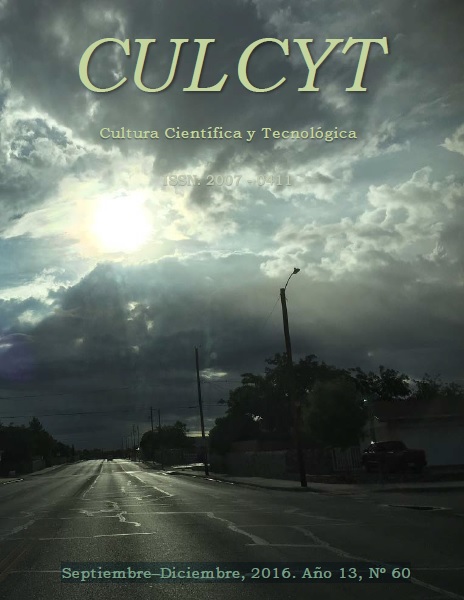Reflexiones acerca de “La escritura dialógica como una herramienta para pensar y aprender sobre el medio ambiente”
Resumen
La escritura dialógica como una herramienta para pensar y aprender sobre el medio ambiente
De Jaime Hylton y John Lemons.
Universidad de Nueva Inglaterra.
Environmental Management (1992) 16: 195.
Descargas
Citas
Berthoff, A. E. 1981. The making of meaning. Boynton/Cook, Upper Montclair, New Jersey.
Bloom, B.S. 1956. Taxonomy of educational objectives: Handbook 1. The cognitive domain. David McKay, New York.
Bruner, J. 1971. The relevance of education. Norton, New York.
Collins, A. 1977. Processes in acquiring knowledge. In R. C. Anderson, R.J. Spirt, and W. E. Montague (eds.), Schooling and the acquisition of knowledge. Lawrence Erlbaum, Hillsdale, New Jersey, pp. 339-363.
Darden, L., and N. Maul. 1977. Interfield theories. Philosophy of Science 44:43-64.
Dewey, J. 1938. Experience and education. Macmillan, New York.
Disinger, J., and J. Opie (eds.). 1986. Environmental education: Progress toward a sustainable future. North American Association for Environmental Education, Troy, Ohio.
Disinger, J., and A. Schoenfeld (eds.). 1987. Focus on environmental studies. The Environmental Professional 9:185-274.
Durst, R. K. 1987. Cognitive and linguistic demands of analytic writing. Research in the Teaching of English 21:347-376.
Emig, J. 1977. Writing as a mode of learning. College Composition and Communication 28:122-128.
Hardin, G. 1974. Living on a lifeboat. BioScience 24:561-568.
Heiman, M., and J. Slomianko (eds.). 1987. Thinking skills instruction: Concepts and techniques. National Education Association, Washington, DC.
Hesse, M. 1966. Models and analogies in science. University of Notre Dame Press, Notre Dame, Indiana.
Hylton, J., and J. Lemons. 1986. Writing as a primary teaching mode in environmental studies courses. Environmental Education and Information 5:155- 162.
Kurfiss, J. 1988. Critical thinking: Theory, research, practice, and possibilities. ASHE-ERIC higher education report No. 2. Office of Educational Research and Improvement, US Department of Education, Washington, DC.
Langer, J. A. 1986. Learning through writing: Study skills in the content areas. Jourruzl of Reading 29:400-406.
Langer, J. A., and A. N. Applebee. 1987. How writing shapes thinking. National Council of Teachers of English, Urbana, Illinois.
Lemons, J. 1984. Can the carbon dioxide problem be resolved? The Environmental Professional 6:52-71.
Lemons, J. 1986. The teaching of values and leadership in environmental programs. In R. Barrass, D.J. Blair, P. H. Garnham, A.O. Moscardini (eds.), Environmental science--teaching and practice. Emjoc Press, North Yorkshire, England, pp. 387-396.
Lemons, J. 1989. Integrating values in environmental curricula. Environmental Management 13:133-147.
Maimon, E., B. F. Nodine, and F. W. O'Connor (eds.). 1989. Thinking, reasoning, and writing. Longman, White Plains, New York.
Newell, G. E., and P. Winograd. 1989. The effects of writing on learning from expository text. Written Communication
:181-217.
Orr, D. 1990. What is education for? The Environmental Professional 12:351-355.
Polanyi, M. 1958. Personal knowledge: Toward a post-critical philosophy. University of Chicago Press, Chicago, Illinois.
Posner, G.J., K. A. Strike, P. W. Hewson, and W. A. Gertzog. 1982. Accommodation of a scientific conception: Toward a theory of conceptual change. Science Education 66:211-227.
Raths, L. E., M. Harmin, and S. B. Simon. 1978. Values and teaching. 2nd. ed. Charles E. Merrill, Columbus, Ohio.
Regan, T. (ed.). 1984. Earthbound. Random House, New York. 371 pp.
Rumelhart, D. E., and D.A. Norman. 1981. Analogical processes in learning. In J. R. Anderson (ed.), Cognitive skills and their acquisition. Lawrence Erlbaum, Hillsdale, New Jersey, pp. 335-359.
Schumacher, G.M., and J.G. Nash. 1991. Conceptualizing and measuring knowledge change due to writing. Research in the Teaching of English 25:67-96.
Sigma Xi. 1990. Entry-level undergraduate courses in science, mathematics and engineering: An investment in human resources. Research Triangle Park, North Carolina.
Sloan, D. 1980. The teaching of ethics in the American undergraduate curriculum, 1876--1976. In D. Callahan and S. Bok (eds.), Ethics teaching in higher education. Plenum Press, New York, p. 2.
Staton, J. 1988. Contributions of dialogue journal research to communicating, thinking and learning. In J. Staton, R. W.
Shuy, J. K. Peyton, and L. Reed (eds.), Dialogue journal communication: Classroom, linguistic, social and cognitive views. Ablex, Norwood, New Jersey, p. 312.
Study Group on the Conditions of Excellence in American Higher Education. 1984. Involvement in learning. US Government
Printing Office, Washington, DC. Tierney, R.J., A. Soter, J. F. O'Flahavan, and W. McGinley. 1989. The effects of reading and writing upon thinking critically. Reading Research Quarterly 24:134-173.
Tulloch, B. 1982. Does science have values? Independent School
:6-14. Vosniadou, S., and W. F. Brewer. 1987. Theories of knowledge restructuring in development. Review of Educational Research 57:51-67.
Vygotsky, L. 1962. Thought and language. MIT Press, Cambridge, Massachusetts.
Wiggins, G. 1989. The futility of trying to teach everything of importance. Educational Leadership November: 44-59.
Wilke, R.J. 1985. Mandating preservice environmental education teacher training: The Wisconsin experience. Journal of Environmental Education 17:1-8
Publicado
Cómo citar
Número
Sección
Licencia
Todos los contenidos de CULCYT se distribuyen bajo una licencia de uso y distribución “Creative Commons Reconocimiento-No Comercial 4.0 Internacional” (CC-BY-NC). Puede consultar desde aquí la versión informativa de la licencia.
Los autores/as que soliciten publicar en esta revista, aceptan los términos siguientes: a) los/las autores/as conservarán sus derechos de autor y garantizarán a la revista el derecho de primera publicación de su obra; y b) se permite y recomienda a los/las autores/as agregar enlaces de sus artículos en CULCYT en la página web de su institución o en la personal, debido a que ello puede generar intercambios interesantes y aumentar las citas de su obra publicada.



